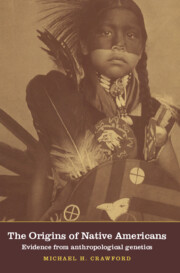Book contents
- Frontmatter
- Contents
- Preface
- Acknowledgement
- 1 Origins of New World populations
- 2 Population size and the effects of European contact
- 3 Demography of Amerindian populations
- 4 Genetic variation in contemporary populations of the Americas
- 5 Population structure of Native Americans
- 6 Morphological variation
- 7 The survivors
- References
- Author index
- Subject index
2 - Population size and the effects of European contact
Published online by Cambridge University Press: 01 May 2010
- Frontmatter
- Contents
- Preface
- Acknowledgement
- 1 Origins of New World populations
- 2 Population size and the effects of European contact
- 3 Demography of Amerindian populations
- 4 Genetic variation in contemporary populations of the Americas
- 5 Population structure of Native Americans
- 6 Morphological variation
- 7 The survivors
- References
- Author index
- Subject index
Summary
INTRODUCTION
The Siberian populations that expanded into the New World some 30 000–40 000 years BP grew numerically, diffused geographically, and eventually reached Tierra del Fuego at the tip of South America. The total number of descendants of the original migrants is a function of the ecological factors in the diverse regions of the Americas and the extractive efficiency of the cultures of residents of these regions. For example, the population densities of hunting and gathering societies were much lower than those of the agriculturalists. As a result, the population densities must have differed in the various regions of the New World, with the highest densities occurring in the Highlands of Central America and Peru, where intensive agriculture could maintain populations of large size. In contrast, the Sonoran or Californian deserts could not have sustained populations of hunters and gatherers with densities greater than a few individuals per square kilometer.
How many Amerindians and Eskimos did inhabit the New World in 1492? Estimates of the size of the population have varied from Dobyns'(1966) 90–112.5 million to Kroeber's (1939) 8.4 million. Dobyns based his numerical estimates upon the reconstructions of population sizes by region when they were at their lowest and then corrected these figures by a 20 : 1 or 25 : 1 depopulation ratio. Kroeber, on the other hand, utilized a tribe-by-tribe ‘dead reckoning’ method (developed by Mooney in 1910) gradually building up totals for each geographical region.
METHODS OF ESTIMATION
Douglas Ubelaker (1988) has summarized the various approaches used to estimate the size of the aboriginal population of North America.
- Type
- Chapter
- Information
- The Origins of Native AmericansEvidence from Anthropological Genetics, pp. 32 - 62Publisher: Cambridge University PressPrint publication year: 1998
- 1
- Cited by



